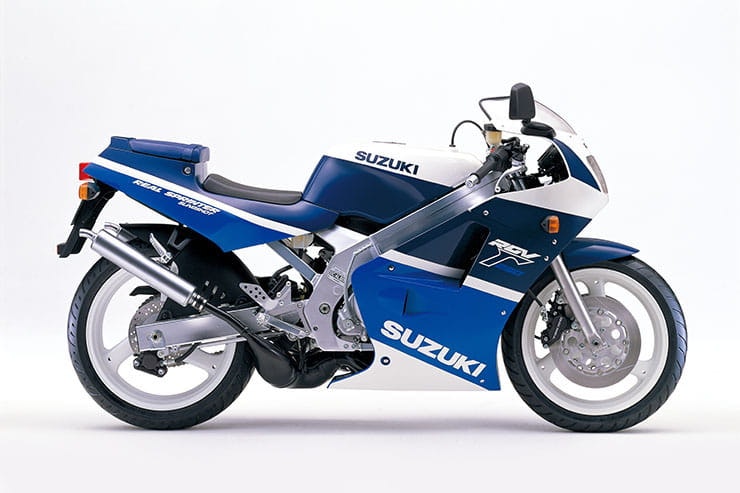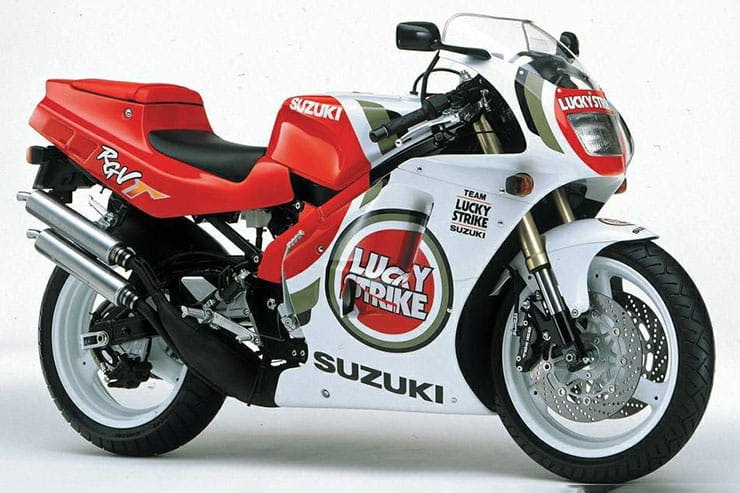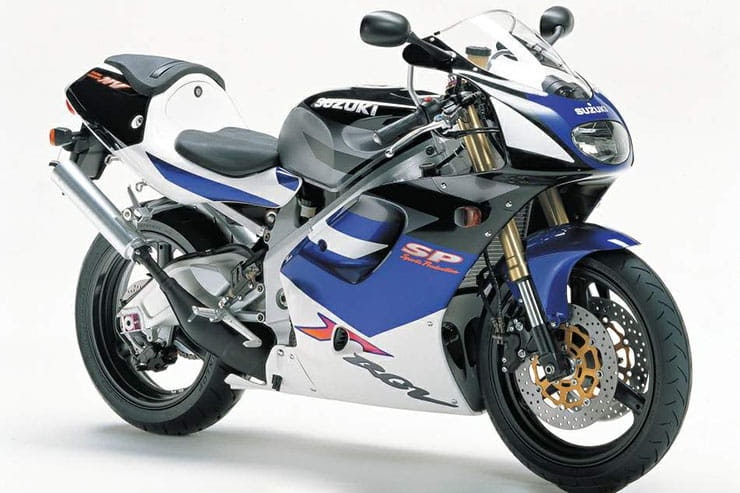Suzuki RGV250 (1988-1999): Review & Buying Guide
By Jim Moore
Bike journo for a quarter of a century
29.03.2023
Price: £5000-£10,000 (VJ22) | Power: 61bhp | Weight: 139kg | Overall BikeSocial Rating: 4/5
Nothing beats the crisp shrill of a two-stroke on-pipe. It’s an aural treat, particularly for those of a certain age who still ride with a finger hovering over the clutch lever. Suzuki’s RGV250 Gamma was the backbone of that soundtrack in the late 1980s and through the ’90s, a time when race replicas were the engine room of the UK motorcycle market. And even though two-strokes stopped rolling off manufacturers’ production lines more than 20 years ago, the RGV250 remains a favourite for those who like their riding dipped in Grand Prix DNA.
When the RGV first arrived in the UK in 1989, two-stroke sports bikes were nothing new. Yamaha’s 250 and 350LCs lit the fuse back in 1980 and Suzuki themselves started the whole 2T race rep trend three years later with the RG250 Gamma. But the RGV was different – special – and on a whole new level to everything that had come before. This achingly beautiful V-twin Suzuki looked like it had escaped from a factory race shop and sprouted lights. Everything about it, from the massive aluminium beam chassis, compact dimensions, engine layout, race-inspired styling and oh-so-trick detailing screamed serious intent. What’s more, the RGV could back up the hype.
Producing a claimed 57bhp – more like 52bhp at the wheel, this 249cc stroker was the first production bike to produce more than 200bhp per litre. Back in ’89 when 1000cc machines were making around 125bhp, the RGV’s bhp-per-cee-cee was big news. Kawasaki’s KR-1 was faster (131mph compared to the RGV’s 126mph) but the green bike was horribly fragile and nowhere near as refined or sophisticated as the Suzuki. In the right hands its razor-sharp handling and laser-focussed performance made the RGV a giant killer and the bane of GSX-R, FZR and ZXR jockeys everywhere. The fact that the RGV was a 250 was irrelevant – it was and still is a brilliant sports bike in its own right, capable of punching way above its size or capacity.
Indeed, the RGV was so ahead of the game that time has done little to diminish the sheer zest or intensity of its ride. There are other 250 race replicas, obviously, like Yamaha’s TZR250, Kawasaki’s aforementioned KR-1/S and Honda’s import-only NSR, but the unashamed link between the RGV and Kevin Schwantz’s factory 500 GP racer – racing’s most popular rider/bike combo of the era, by far – set this Suzuki apart in the most enticing of ways.
Even now, more than 30 years on, no other 250 race replica enjoys a following quite like the RGV – even Aprilia nabbed the Suzuki’s engine for its RS250. That popularity, allied with a continuity of enthusiasm from owners about these bikes, not to mention the fact UK RGVs offer full power motors in the era’s sweetest chassis, makes this Suzuki the go-to-choice for anyone wanting to own, enjoy and cherish one of these legendary two-stroke race replicas.
Still a thrill to ride, even more than 30 years on from launch
Plenty of spares/technical back-up still out there
Easy to modify for more performance (300cc kit, pipes, tuning etc)
VJ21’s 18in rear wheel limits tyre choice
VJ23 models are restricted to 40bhp. J-spec 21s and 22s are 45bhp
Any RGV requires meticulous and regular maintenance if it’s to remain reliable
Suzuki RGV250 (1988-1999) Prices
Suzuki’s RGV250 is available in three flavours: VJ21 model (1988-1990); VJ22 (1990-1995); VJ23 (1996-1999). That said, RGV lineage can be confusing because Japanese market models didn’t run concurrently with UK bikes; the home market was always a year ahead in terms of updates and spec because the original RGV, the 250J, went on sale in Japan in 1988. Subsequently, our K model is equivalent to the Japanese ‘J’ and so on… It’s easy to spot Japanese import RGVs, however. J-spec VJ21s have teardrop indicators, oval mirrors on concertina stalks, kph speedos, speed indicator lights, drilled discs and 45bhp motors. VJ22s are more subtle with smoked indicators, kph speedos, different graphics and drilled discs. All VJ23s are Japanese market machines.
VJ21s feature conventional telescopic forks, an unbraced swingarm, pipes exiting both sides and fairing-mounted clocks. Suzuki claimed 57bhp for the K and a dry weight of 128kg. Original UK colours were blue/white only. The 1990 UK model L looks identical except for its fully adjustable remote-reservoir shock. Other changes include a new engine management system controlling ignition, powervalve operation and fuelling. Porting was also revised. UK colours: blue/white, red/white, black/graphite.
A Sports Production variant of the VJ21 was sold in Japan, featuring a close-ratio gearbox and fully adjustable suspension. This was available in blue/white or limited edition Pepsi GP colours.
VJ21 values: Rough £3000-£3800; Tidy £4500-£7000; Mint £7500-£9000
Like the VJ21, the 22 appeared in Japan a year before reaching the UK. Our first VJ22, the 1991 250M, is radically different from earlier RGVs, with a stiffer frame, a ‘banana’ style swingarm allowing clearance for twin right-side pipes, upside-down forks, a 17in rear wheel, sleeker styling, three-stage powervalves (VJ21 valves are two-stage), an updated engine management system, bar-mounted clocks and more power – up by 4bhp to 61bhp. UK colours, blue/white or black. The ’92 N model got minor tweaks – two vent slits in the seat units as opposed to the M’s three, and new colours: blue/white or black/teal, both with slash graphics. Japan-only Sports Production VJ22s feature usual SP attire and dry clutches.
Later VJ22s – P and R – lost the ‘banana’ swingarm (due to a patent dispute with Honda who ran a ‘Gull-Arm’ on their own NSR250R) which was replaced by a conventionally braced unit. Other than that, and a final tweak to the powervalves, the spec remained the same bar graphics updates. UK Colours: blue/white or black/purple. SP variants continued to be made for the domestic market, as did a limited-edition Lucky Strike model built to celebrate Kevin Schwantz’s 1993 500GP title win. From ’93 Japanese models were restricted to 40bhp.
VJ22 values: Rough £3000-£4000; Tidy £5000-£7500; Mint £8000-£10,000
The final RGV, the VJ23, shares nothing with previous models, being a completely new bike from the ground up. It was sold only in Japan. New 70° V-twin engine, a more compact chassis (wheelbase reduced by 50mm), a return of the ‘banana’ rear swingarm and radically different styling to the older models. Power was pegged at 40bhp by Japanese law, but a factory F3 kit could raise output to 70bhp-plus for racing. Available only in SP spec. Colours: white/blue/purple, blue/white/graphite, or Lucky Strike.
VJ23 values: Rough £6000-£8000; Tidy £10,000-£14,000; Mint £15,000-£17,000
Suzuki RGV250 (1988-1999) Engine and Performance
The RGV250 was notable against its UK market opposition because of its V-twin engine. Yamaha’s TZR250 2MA and Kawasaki’s KR-1 were parallel twins. Only Honda’s Japan-only NSR shared the GP-inspired layout. And although Suzuki didn’t run a GP 250 bike at the time, this road bike bristled with technology gleaned from the factory’s RGV500 racer.
The RGV250’s motor is compact, running a 90° vee-angle, inclined forward by 20° to give the whole package a desirably low centre of gravity. The cylinder bores – dimensionally over-square at 56 x 50.6mm – are plated with a nickel/phosphor alloy (Suzuki call it SBC, Suzuki Boron Composite) to minimise friction and increase piston ring life. Fuelling on the VJ21 is via twin 32mm ‘Slingshot’ carbs featuring part flat/part round slides to reduce turbulence in the mixture swell, promoting a greater volume of charge into the crankcase.
Suzuki called the RGV’s powervalve mechanism AETC, or Automatic Exhaust Timing Control in its full pomp. The system reduces the size of the exhaust ports at low rpm and increases it at higher rpm, via guillotine-style blades, resulting in optimum low-down and midrange torque plus maximum performance in the upper reaches of the rev range. Suzuki claimed 57bhp@11,000rpm and 27.4lb.ft@10,800rpm for the VJ21. New exhausts, a three-stage AETC system, 2mm bigger carbs, a thicker radiator (still curved for maximum surface area) and an uprated engine management system increased output of the VJ22 to a claimed 61bhp@11,000rpm and 28.9lb.ft@11,000rpm. Performance is peaky yet addictive on both 21 and 22 models yet, crucially, 10-15bhp up on restricted imports like Honda’s NSR and Yamaha’s 3MA and 3XV TZRs.
The VJ23 is radically different and restricted to just 40bhp. The emphasis is on tractability and maximising performance within the confines of Japanese law. A revised bore and stroke (54 x 54.5mm) in an even more compact 70° V-twin layout sets out the VJ23’s stall. A return to 32mm carbs aids low and midrange torque. There’s potential aplenty inside the engine, however. Suzuki’s F3 race kit takes output to 70bhp-plus.
Suzuki RGV250 (1988-1999) Handling & Suspension
Handling, as you might expect, is an RGV strong suit. The VJ21 is the lightest model, tipping the scales at just 128kg. A change in spec to upside-down forks, and a bigger banana swingarm increased the VJ22’s mass to 139 kilos dry – still modest considering the motor’s 60bhp-plus claimed output.
Both models’ dual-cell aluminium beam frames are incredibly stiff, but the VJ22 is the sweeter handler of the two on account of its superior suspension (fully adjustable shock and 41mm preload adjustable usd forks; note SP models benefit from fully adjustable suspension front and rear) and better tyre choice thanks to a 17in rear wheel. The 22’s steering, while still wonderfully light and accurate, is less flighty than the 21’s due to the extra weight imposed on it by the bar-mounted clocks.
That said, any RGV still on its stock suspension would now benefit massively from a fork/shock rebuild or upgrade. Some owner retrofit 22 forks, wheels and suspension to 21s to gain the newer bike’s advantage. Braking can be an issue on early RGVs; the stock Tokico calipers are poor by modern standards. Retro fitting later Suzuki Nissins (GSX-R parts are a relatively easy fit) is a common upgrade.
Suzuki RGV250 (1988-1999) What to look for
Engine: A highly tuned unit for road use, so extra tuning will shorten the life of the pistons and crank. The original plating on the bores does wear, heightening the risk of seizure. Ceramic plating is now the favoured upgrade; it encourages cooler running and therefore less likelihood of a hotspot, as well as absorbing oil for better lubrication. K models run pistons unique to them; L-R models run the same pistons. RGV gearboxes were never great. The jump from first to second is long and promotes premature wear. SP-model gearboxes with their high first gear and close ratios thereafter are prized, but rare and expensive as a result.
Powervalves: The source of sleepless nights for many an RGV owner. Unlike Yamaha’s rotating drum YPVS system, Suzuki’s AETC (Automatic Exhaust Timing Control) uses guillotine style blades to open and close the exhaust ports. This means lots of moving parts, all of which wear – the worst offenders are the pins that hold everything together. Once worn, they allow the blades to drop far enough to touch the pistons; cue extensive and expensive rebuild. The issue is most serious on VJ22 engines. VJ21s run a simpler system, but it still requires regular maintenance if it’s not to cause a pricey catastrophe.
Servicing: RGVs demand meticulous maintenance. Top quality full-synthetic 2T oil is a must. Refresh piston rings every 3000 miles, pistons every 6000 miles. Powervalves should be checked/serviced every second service to ensure they don’t disintegrate into the cylinders. Change the gearbox oil every service, too. A full engine strip and rebuild should be considered by 15,000 miles.
Suspension: VJ21 suspension is fairly basic, so upgrades to better shocks and modern fork internals are welcome – only the L model’s fully adjustable shock is worth having in terms of early bikes. VJ22 suspension is better; preload adjustable usd forks and a fully adjustable shock, although by now a refresh would be advisable. Rear linkages can often be forgotten come service time.
Ex-race/crash damage: RGVs were a club racer’s dream: fast, easy to tune and relatively cheap to repair when crashed. Buying an ex-race bike is fine as long as you know its history. Scarred frames/swingarms, scuffed pipes, drilled sump plugs, overly zingy motors, and low miles on the speedo are all tell-tale signs. Front end crashes had a habit of ruining VJ22 frames, such was/is the strength of the forks. Look for cracked welds. Shock mounting lugs can also snap – check for repairs. Run an HPI check, too.
Imports: There are positives and negatives to buying a Japanese market RGV. J-spec VJ21s look prettier with their tear drop indicators, drilled discs, smaller mirrors and different colour options, but the engines are restricted to 45bhp through the CDI and jetting. Derestriction is possible but you’ll need UK model parts. It’s the same deal with VJ22s. Suzuki also sold a naked variant in Japan, the TV250 Wolf, which is essentially an unfaired VJ21 with a single front disc, a round headlamp, different clocks, a smaller radiator and no fairing lug on the headstock. SP models are only available as Japanese imports.
VJ23: Final model RGVs are rare and expensive. They’re also slower than earlier bikes on account of their home market restricted engines. They are, however, relatively easy to tease more power from – less restrictive pipes and ignition systems can yield decent gains. You’ll want to get friendly with a respected grey importer too, like Fastline Superbikes in Preston, who can find spares in Japan if and when you need them.
Suzuki RGV250 (1988-1999) Rivals
Honda NSR250R MC21/28, year | Approx Price: £7000-£14,000 (MC21); £12,000-£20,000 (MC28)
Power/Torque: 45bhp/25.8lb-ft | Weight: 132kg
Japanese import only, so MC21 models are 45bhp and MC28 are 40bhp, but they offer a broad spread of power, impeccable handling and genuine GP pedigree. There are three specs: R, SE and SP; the latter being Sports Production with magnesium wheels and dry clutch. MC28 comes with unique smart card ignition and single-sided swingarm. The lighter 21 is for GP purists.
Yamaha TZR250 3MA/3XV, 1989-1998 | Approx Price: £4500-£8000 (3MA); £6500-£15,000 (3XV)
Power/Torque: 45bhp/26.2lb-ft | Weight: 128kg
UK-spec 2MA TZRs were a generation behind VJ21 RGVs, but the Japan only reverse-cylinder 3MA and V-twin 3XV are a match for the Suzuki. 1989 3MAs are fragile with poor fuelling; 1990 bikes much improved. The 3XV is a gem – light, quick and like a pukka race bike for the road. SP and SPR specs are extremely rare; the plain R is best value.
Aprilia RS250, 1994-2004 | Approx Price: £6000-£10,000 (MK1); £6000-£12,000 (MK2)
Power/Torque: 55bhp/27lb-ft | Weight: 141kg
RGV-powered Italian using a VJ22 engine reworked by Aprilia. MK1 RSs are arguably the prettiest 250 ever built. Both models are roomier than NSRs and TZRs, so are better suited to Europeans. Engines can be tuned as per RGVs. Many have been raced/tracked and crashed, so be wary what you’re viewing.
Suzuki RGV250 (1998-1998) Verdict
Suzuki’s RGV250 stands out from all of its competitors for several key reasons. Firstly, it was imported into the UK so, unlike NSRs and later TZRs, full-power bikes are easily found. Secondly, they were popular so expertise, spares support and technical knowledge is far easier to find than for the aforementioned greys. Thirdly, and most crucially, they’re ace. Riding an RGV is a life-affirming experience – pure, undiluted, adrenaline in a light, nimble, eager package that’s still affordable. Just. Our pick is the VJ22, packing the most performance into a chassis and style that still excites. Be quick if you want one though; two-stroke values aren’t set to decrease anytime soon…
Suzuki RGV250M (1991) spec
Looking for motorcycle insurance? Get a quote for this motorbike with Bennetts bike insurance


